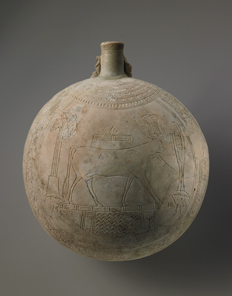Events
December 16, 2011
New Year's bottle holds good wishes

A New Year's bottle from the Carlos Museum collection. (Photo by Bruce M. White)
The festival-loving, ancient Egyptians, according to Michelle Marlar, deemed giving specially made New Year's bottles a rite or tradition.
Marlar, assistant professor of visual arts at Morehouse College, spoke about the bottles, on which she has done extensive research, at the Carlos Museum's AntiquiTEA on Dec. 6.
The museum has a collection of these bottles and "is fortunate to have one that has additional decoration on the front, and that's relatively rare," Marlar said.
The size of the flattened, circular bottles with their tiny necks indicates that they were not used as drinking vessels but perhaps more as symbols of good wishes of the New Year.
"Thanks to texts, we know that on New Year's Day, there was a big solar festival and most likely these bottles are in some way associated with that solar festival," said Marlar.
She noted that the bottles' very small opening precludes the idea that something was poured in as a libation. "So maybe it was just given containing water as an offering in either a temple or as a gift on New Year's," she said.
"The basic wish," inscribed on the bottles, "invokes various deities for a ‘good opening of the New Year' for its owner," she said.
Made of faience — crushed up quartz mixed with plant ash and natron — the bottles would have been bright and gleaming in their day. They are very light and delicate, Marlar said.
The most frequently occurring name on the New Year's bottles was Ptah, the creator god, said Marlar. His counterpart, Sekhmet, is also often named.
"I tell my students whenever you're looking at Egyptian art, keep in mind there's going to be some sort of deeper meaning to it," Marlar said.
To figure out the purpose of these bottles, "I tried to look at what kind of symbolism they have." She found they have a very strong solar symbolism. Their sun-resembling shape is "not a perfect circle. It's flattened, like sun on the horizon."
Other connections between the bottles' symbols and meaning in Egyptian religion and life were beetles, which represent the sun; the gleaming quality of the faience mirroring the sun's face; the colors green and blue, which represent flourishing and rebirth; and papyrus and lotus, plants that grow out of the water and symbolize prosperity and rebirth.
"You can see it very easily being given as a gift. In its shape and in its color, in its standard details, all of that ties into this idea of solar rebirth," Marlar said.
"There is a real religious significance to these New Year's bottles," she said, tied into water, beginnings and rebirth.
